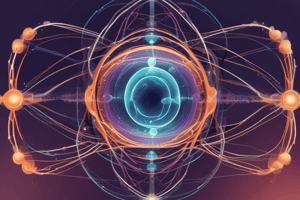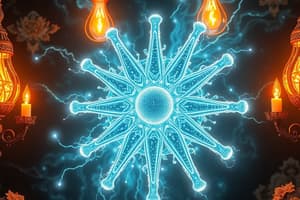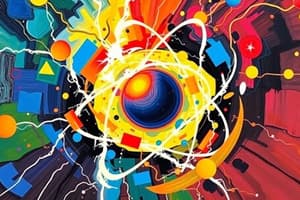Podcast
Questions and Answers
What does it mean for electric charge to be quantized?
What does it mean for electric charge to be quantized?
- Charges are unlimited in quantity without restrictions.
- Charges can be split into fractional values.
- All charges are whole-number multiples of elementary charges. (correct)
- Electric charge can change based on temperature.
According to Coulomb's Law, how does the force between two point charges change if the distance between them is doubled?
According to Coulomb's Law, how does the force between two point charges change if the distance between them is doubled?
- The force remains the same.
- The force doubles.
- The force quadruples.
- The force is reduced to one quarter. (correct)
What characteristic defines a superconductor?
What characteristic defines a superconductor?
- Infinite conductivity at a critical temperature. (correct)
- High resistance at low temperatures.
- Behavior similar to insulators at all temperatures.
- Limited conductivity that varies constantly.
Which type of material allows charges to move freely?
Which type of material allows charges to move freely?
Which factor does NOT play a role in the strength of an electric field?
Which factor does NOT play a role in the strength of an electric field?
What happens to the total electric charge in the universe during any physical process?
What happens to the total electric charge in the universe during any physical process?
In the scenario provided, what is the force of attraction between two-point charges with Q1=4.0μC and Q2=-2.0μC placed 3 cm apart?
In the scenario provided, what is the force of attraction between two-point charges with Q1=4.0μC and Q2=-2.0μC placed 3 cm apart?
What defines a semiconductor?
What defines a semiconductor?
Flashcards
Electric Field
Electric Field
It is the amount of electric force per charge.
Coulomb's Law
Coulomb's Law
The magnitude of the electric force between two point charges is directly proportional to the product of the charges and inversely proportional to the square of the distance between them.
Conductor
Conductor
A material that allows charges to move freely through it.
Insulator
Insulator
Signup and view all the flashcards
Semiconductor
Semiconductor
Signup and view all the flashcards
Superconductor
Superconductor
Signup and view all the flashcards
Quantized Charge
Quantized Charge
Signup and view all the flashcards
Conservation of Electric Charge
Conservation of Electric Charge
Signup and view all the flashcards
Study Notes
Disclaimer
- This presentation, including examples, images, and references, is for informational purposes only
- Credits for images are given to open-source sources
- Images will not be used in any promotional activities
Lesson 1
- The lesson covers electric charge, Coulomb's Law, electric field, and electric flux
- Electric charge is derived from the Greek word "Elektron" which means "Amber"
The Structure of an Atom
- Atoms are composed of three subatomic particles: protons, neutrons, and electrons
- Protons and neutrons are located in the nucleus at the center of the atom
- Electrons orbit the nucleus in energy levels
The Sub-atomic Particles
- Proton: Relative size (exaggerated), Mass (1.67 x 10-27 kg), Charge (+1.602 x 10-19 C)
- Neutron: Relative size (exaggerated), Mass (1.67 x 10-27 kg), Charge (0)
- Electron: Relative size (exaggerated), Mass (9.11 x 10-31 kg), Charge (-1.602 x 10-19 C)
Charge is Quantized
- All charge objects have a charge that is a whole number multiple of the charge of a single electron or proton.
- Electron charge: -e = -1.60 x 10-19 C
- Proton charge: +e = +1.60 x 10-19 C
- Neutron: electrically neutral
Conservation of Electric Charge
- The total charge in the universe is constant
- No physical process can result in an increase or decrease in the total charge of the universe
Conductors and Insulators
- Conductors: Allow charges to move freely
- Insulators: Charges are not free to move
5 Electrical Conductors
- Silver
- Gold
- Copper
- Steel
- Sea water
5 Electrical Insulators
- Rubber
- Glass
- Oil
- Diamond
- Dry wood
Semiconductors
- Can be made to behave sometimes as an insulator and sometimes as a conductor
- Examples include Boron (B), Silicon (Si), Germanium (Ge), Arsenic (As), Antimony (Sb), and Tellurium (Te)
Superconductors
- Possess infinite conductivity to the flow of charge
- Current passes without losing energy at a critical temperature
Gravity vs Electric Force
- Gravity: Origin - masses, Formula - F = Gm1m2/r2, Type of force - Attractive
- Electric force: Origin - charges, Formula - F = Kq1q2/r2; Type of force - Attractive/Repulsive
Coulomb's Law
- The magnitude of the electric force between two point charges is directly proportional to the product of the charges and inversely proportional to the square of the distance between them
- k = 8.99 × 109 N m2/C2
- ɛ0 = permittivity of free space = 1/(4πε0)
Electric Field
- The amount of electric force per unit charge
- More field lines = stronger electric field
- Closer field lines = stronger electric field
- Lines start from positive and end on negative charges
- Field lines never cross
- Direction of force = direction of electric field
- E = kq/r2 (electric field intensity)
Other Important Notes
- Various examples and calculations relating to electric charges are included in the notes
Studying That Suits You
Use AI to generate personalized quizzes and flashcards to suit your learning preferences.




